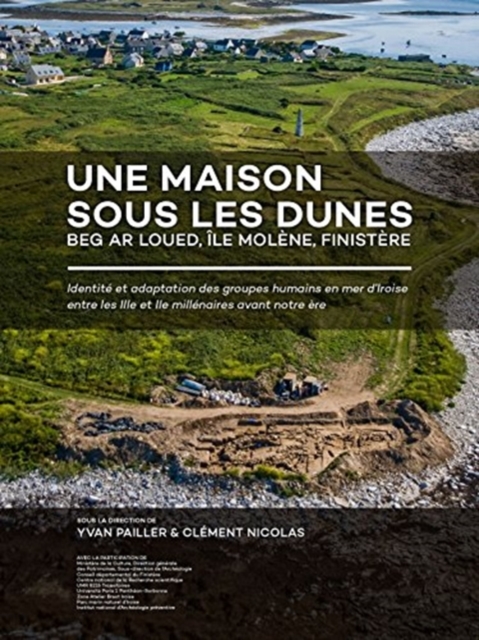CITESTE MAI MULT
Detalii
Descriere RO
Description fran�aise
Depuis 2001, des recherches arch�ologiques sont men�es dans l'archipel de Mol�ne. Ce secteur s'av�re particuli�rement riche en vestiges du N�olithique et de l'Age du Bronze. Une concentration exceptionnelle de monuments m�galithiques y a �t� mise en �vidence.
Plusieurs habitats sont attest�s par la pr�sence de d�potoirs domestiques. A la pointe de Beg ar Loued (�le Mol�ne), l'un de ses amas coquilliers fit l'objet d'un premier sondage en 2003 marquant le d�but d'une s�rie de campagnes de fouilles. D�s la deuxi�me ann�e, celle-ci prit un tournant d�cisif avec la reconnaissance des premiers murs en pierres s�ches, correspondant � un b�timent conserv� sous la dune. Pendant pr�s d'une d�cennie, ce site fit l'objet de fouilles par une �quipe interdisciplinaire. Les donn�es obtenues par l'�tude de l'habitat renseignent sur la chronologie des diff�rentes occupations du site et permettent de documenter la transition IIIe-IIe mill�naire avant notre �re, fourchette chronologique encore tr�s mal connue dans la moiti� nord de la France.
Outre l'apport d'une chronologie relative, l'approche architecturale donne une meilleure compr�hension des choix ayant pr�sid� aux diff�rentes phases de construction du b�timent occup� pendant plus de trois si�cles. Les �l�ments de la culture mat�rielle (c�ramique, lithique, m�tallurgie) viennent aussi soulever le voile sur une p�riode essentiellement connue en Bretagne � travers les monuments fun�raires.
Pour la premi�re fois dans cette r�gion, gr�ce � la conservation des vestiges organiques, il est permis d'esquisser l'�conomie (�levage, agriculture p�che, collecte des coquillages, etc.) des hommes ayant occup� les rivages de la mer d'Iroise. Leur mode de vie sugg�re une communaut� s�dentaire � �conomie vivri�re, exploitant l'ensemble des ressources insulaires sans pour autant �tre coup�e du continent (style c�ramique, m�tallurgie). Afin de mieux comprendre l'�volution globale de cet environnement insulaire, de nouvelles recherches ont �t� men�es sur les variations du niveau marin corr�l�es � l'�tude du paysage v�g�tal, de la g�omorphologie, de la g�ologie et de la faune.
English abstract
Since 2001, archaeological research has been conducted in the Mol�ne Archipelago, an area that is particularly rich in remains from the Neolithic and the Bronze Age, with an exceptional concentration of megalithic monuments.
Several settlements are attested by the presence of domestic refuse dumps. At the point of Beg ar Loued (Mol�ne Island), one of those shell middens was the object of an initial sondage in 2003, and that marked the beginning of a long series of excavations. Fieldwork took a decisive turn during the second year with the recognition of the first dry stone walls, belonging to a building preserved within the sand dunes. For nearly a decade, this site has been excavated by an interdisciplinary team. The data that have been obtained from this fieldwork provide information on the chronology of the various periods of occupation of the site and help to document the 3rd-2nd millennium BC transition, a period still largely unknown in the northern half of France.
In addition to providing a relative chronology, the architectural approach gives us a better understanding of the choices that governed the different construction phases of the building, which was occupied for over three centuries. The elements of material culture (pottery, lithics, metalwork) also shed light on a period essentially known in Brittany through its funerary monuments.
For the first time in this region, thanks to the preservation of organic remains, it is possible to sketch the lifestyle (livestock management, agriculture, fishing, shell gathering, etc.) of the people who occupied the shores of the Iroise Sea. In order to understand better the overall trends in this insular environment, new researches have been carried out on sea level changes in tandem with the study of the palaeoenvironment, geomorphology, geology and wildlife.
EdituraSidestone Press
Dimensiuni290 x 219 x 41
Data Publicarii28/11/2018
Format
Cartonata
Numar pagini800
Aceasta este o carte in limba engleza. Descrierea cartii (tradusa din engleza cu Google Translate) este in limba romana din motive legale.
Descriere in limba engleza Din 2001, cercetarile arheologice au fost efectuate in arhipelagul Molne. Acest sector este deosebit de bogat in vestigii din neolitic si epoca bronzului.

